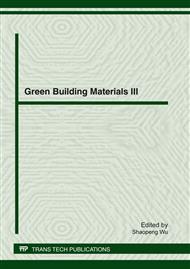p.65
p.74
p.82
p.88
p.93
p.99
p.106
p.113
p.119
Study on the Volatility of Organic Contaminated Soil from Tar Workshop
Abstract:
The pollution soil from tar workshop’s foundation soil in a steel work, first of all, the main organic pollutants in pollution soil are examined by the Pony Test Center. Then, the volatility of the pollution soil at different temperature was studied by thermo gravimetric (TG) analysis coupled with Fourier transform infrared spectroscopy (FTIR). At last, by adding standard reagents of PAHs respectively, their volatility of different temperature period was confirmed. The results indicated that the main organic pollutants in the contaminated soil were fluorene, acenaphthene, phenanthrene, fluoranthene, pyrene and so on, the total content is about 156.39ppm. the weight loss of pollution soil mainly occurred at the temperature ranges of room temperature to 215°C, 215~670°C and 670°C~850°C. There were H2O and CO2 coupled with the weight loss. When temperature increased further up to and above 850°C, the weight tended to be stable. The volatilization of PAHs is mainly in the section of 215~670°C, and their fastest volatilized temperatures in pollution soil were lower about 30°C than their respective boiling points.
Info:
Periodical:
Pages:
93-98
Citation:
Online since:
April 2012
Authors:
Keywords:
Price:
Сopyright:
© 2012 Trans Tech Publications Ltd. All Rights Reserved
Share:
Citation:


